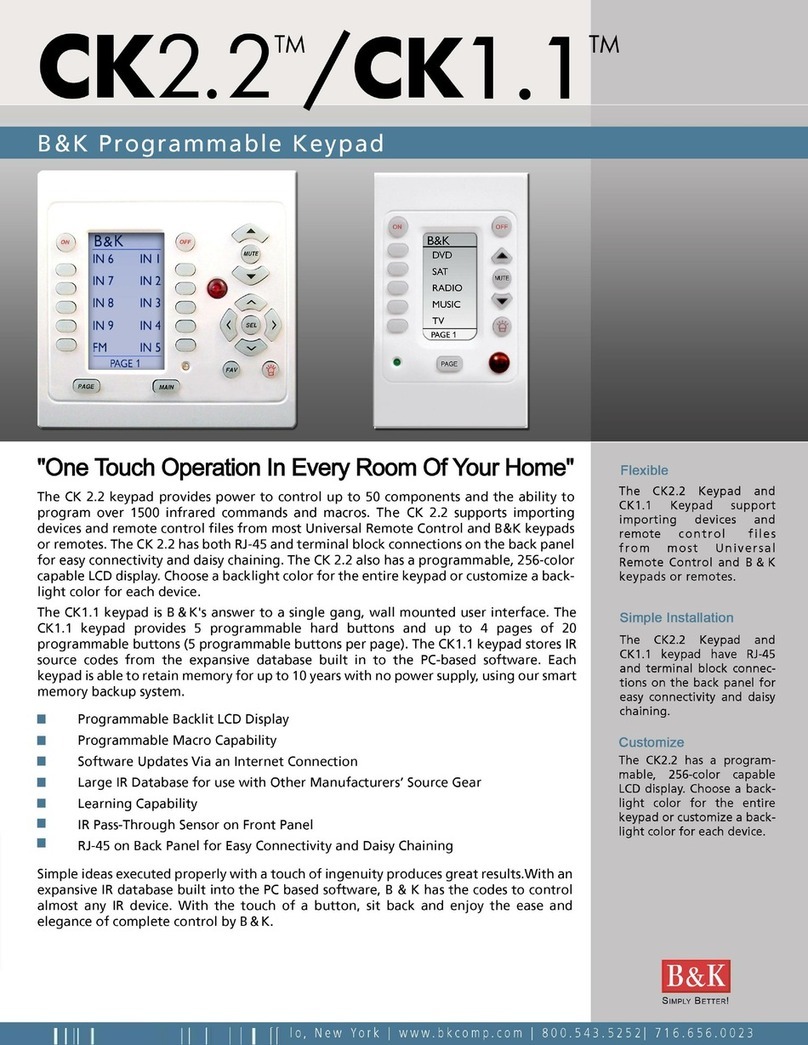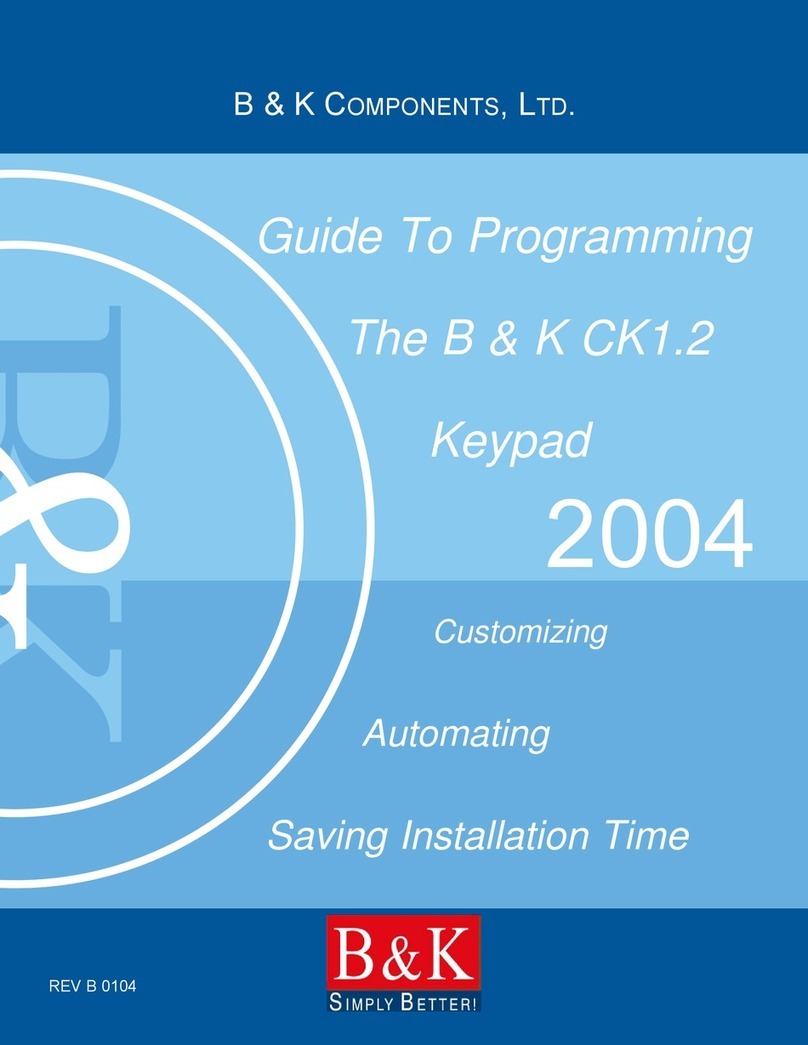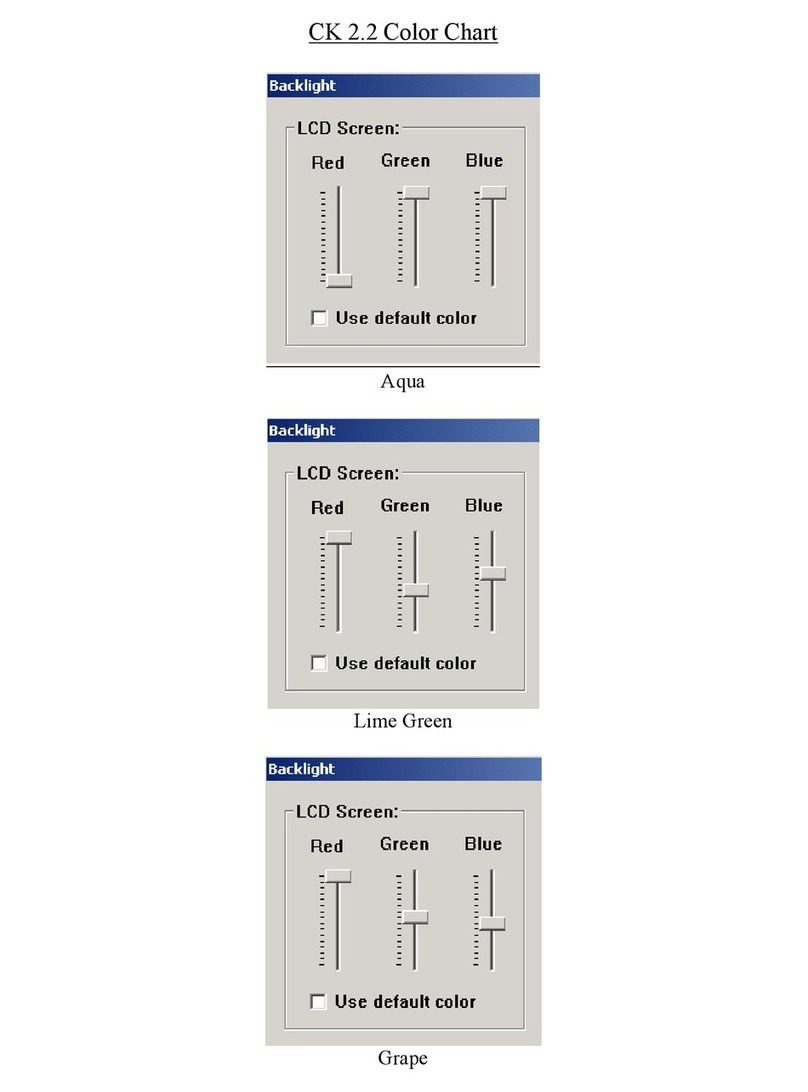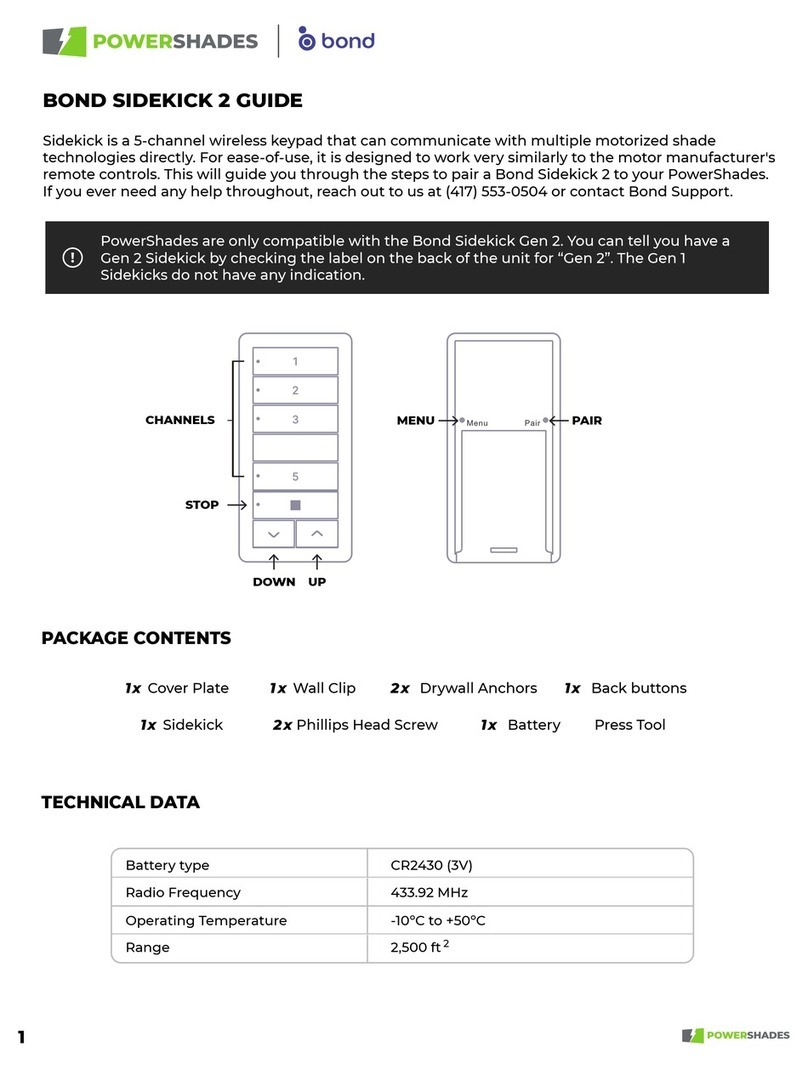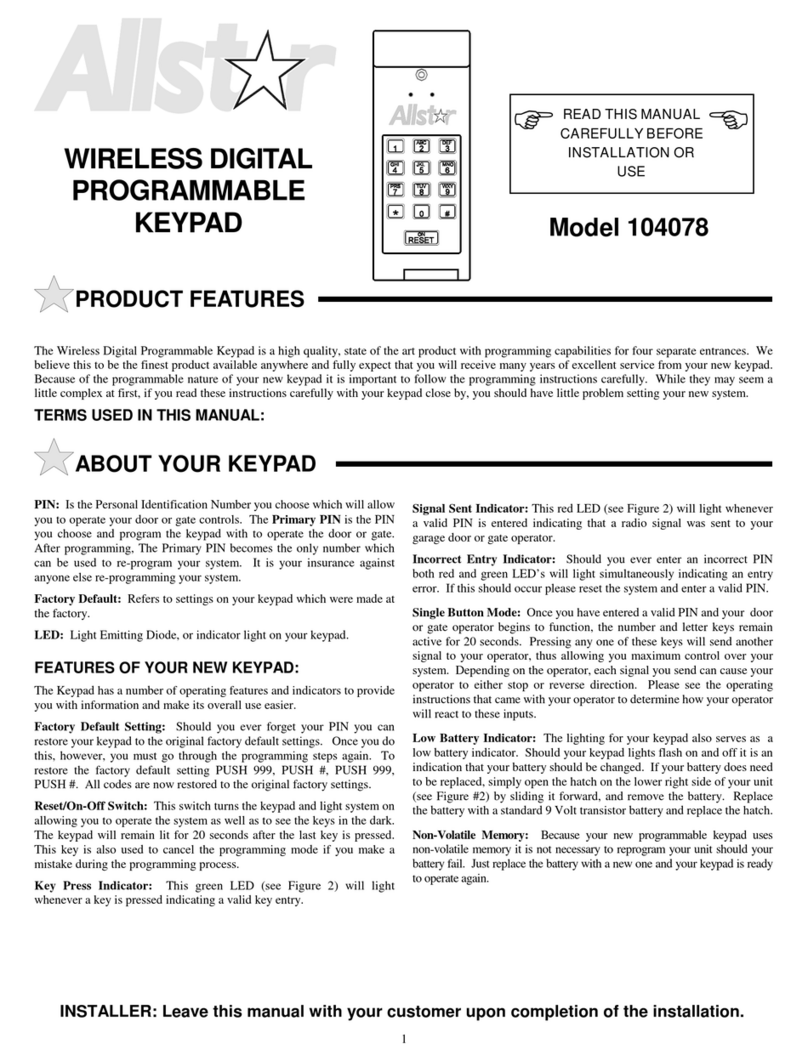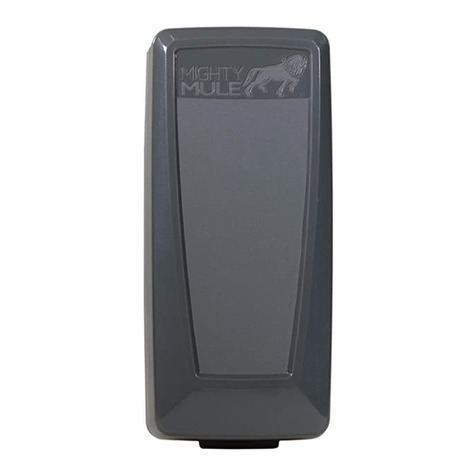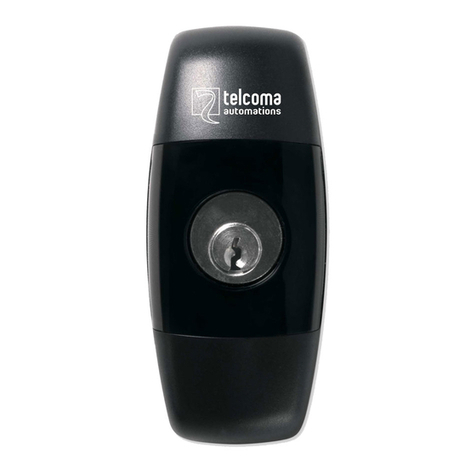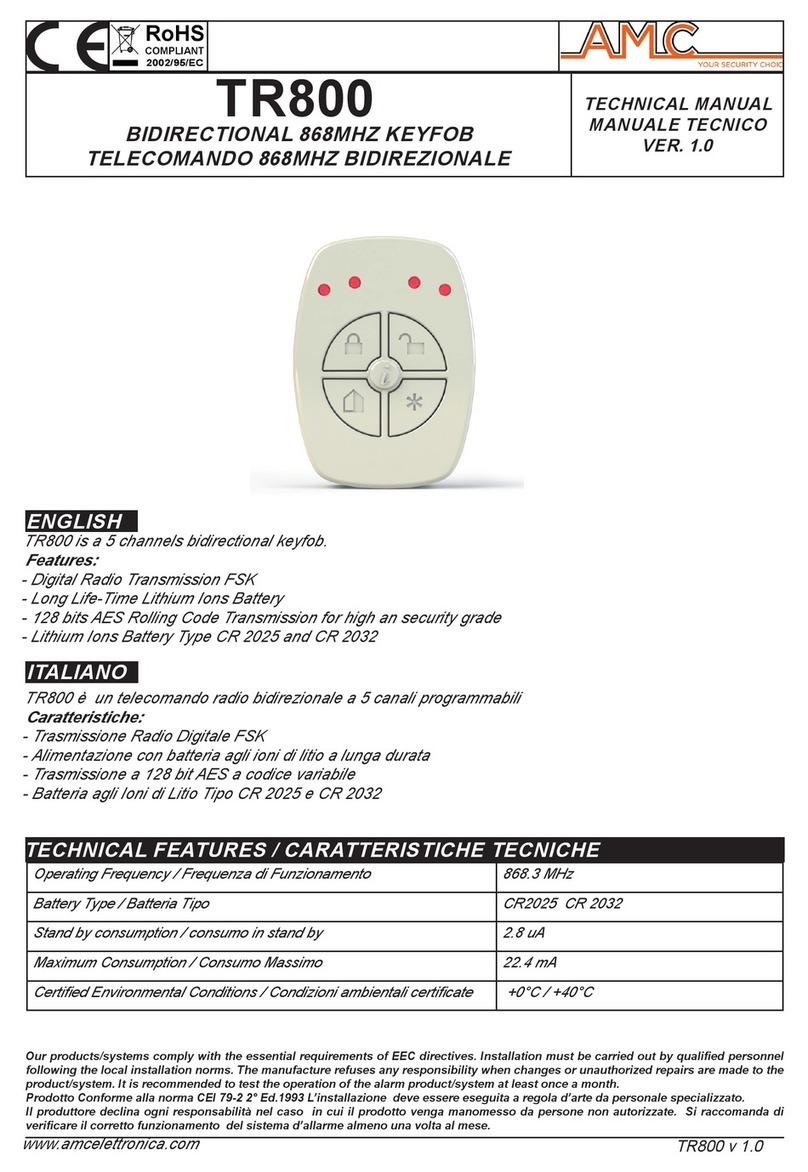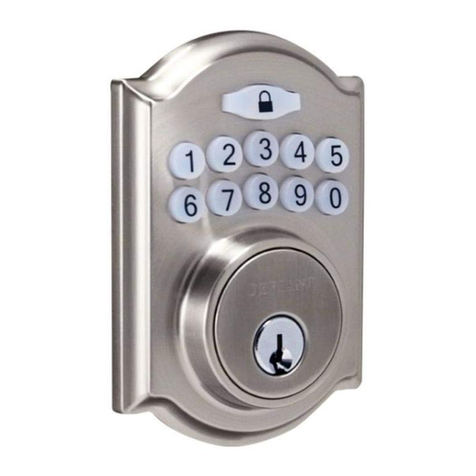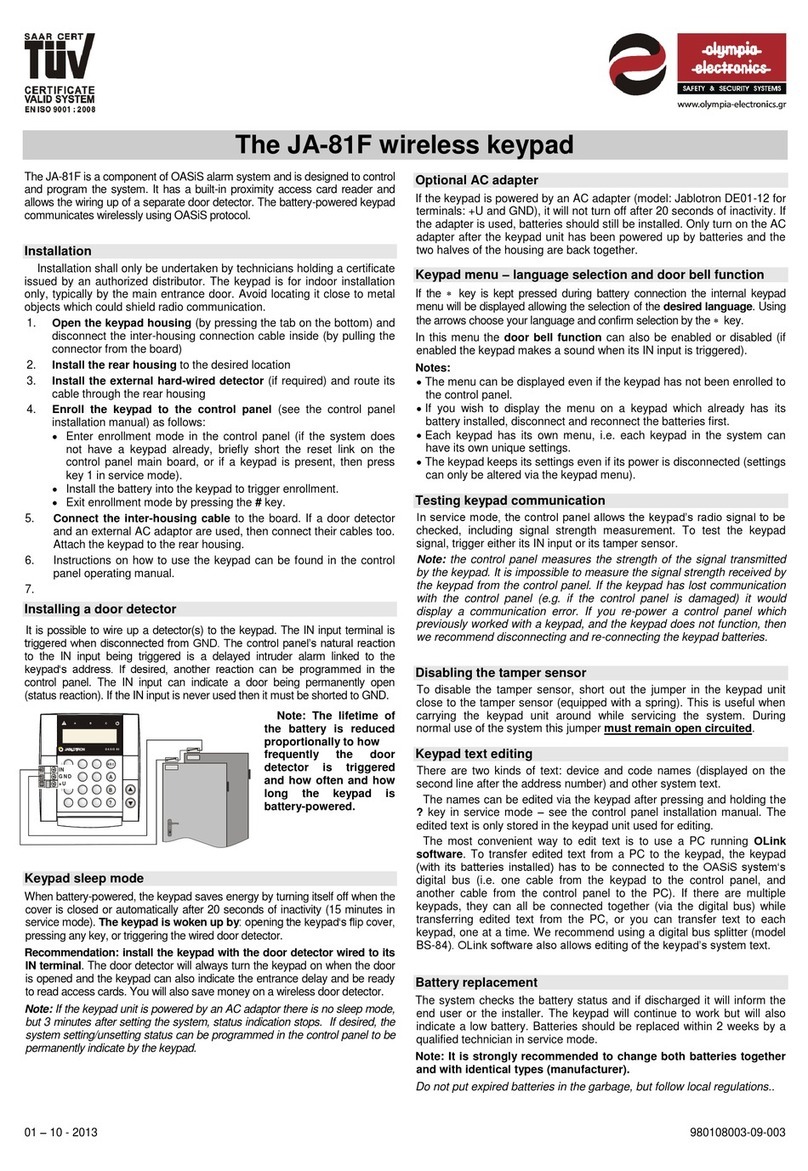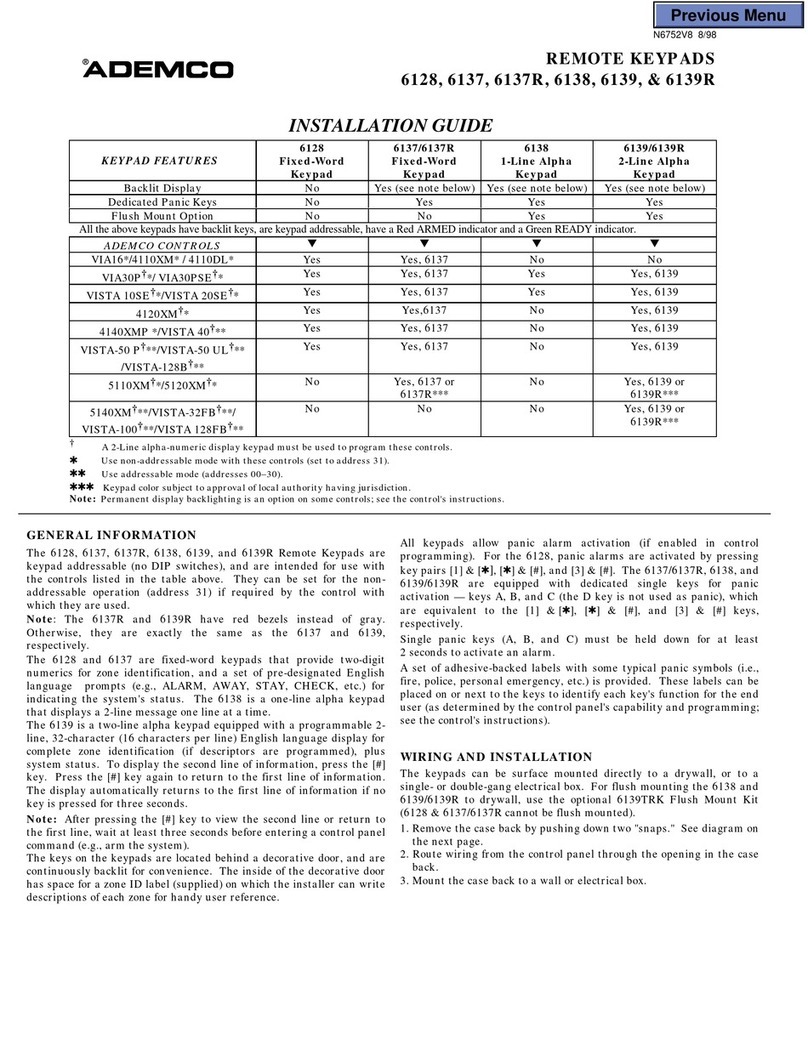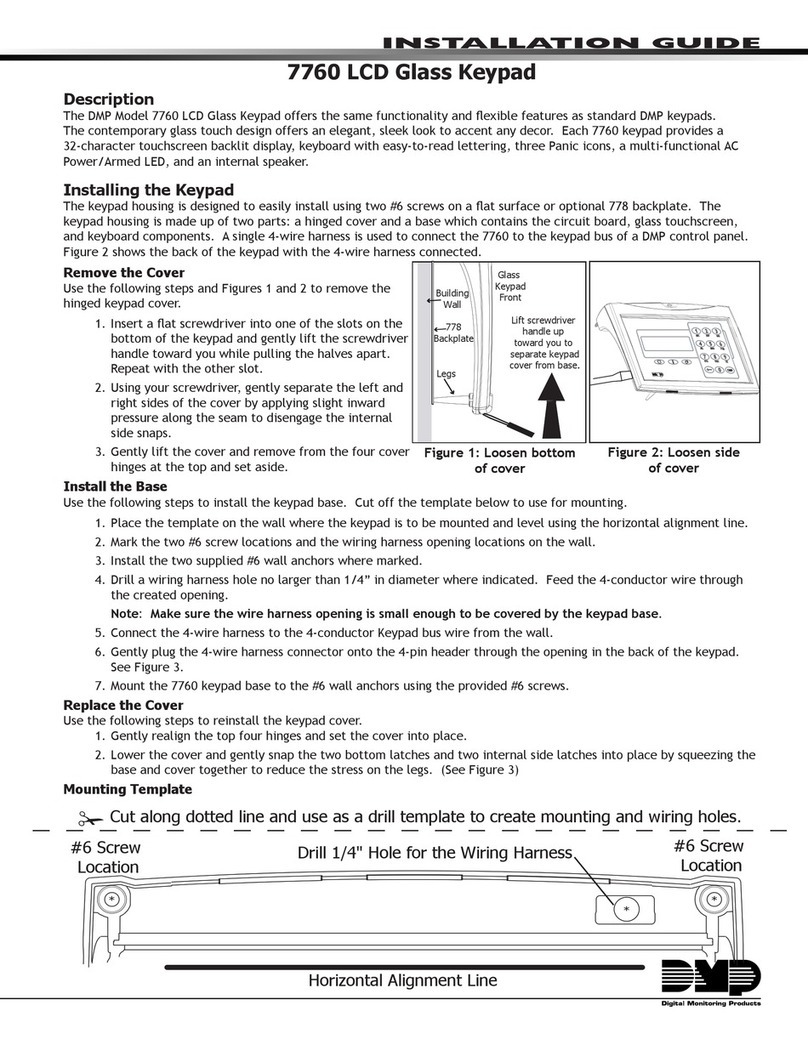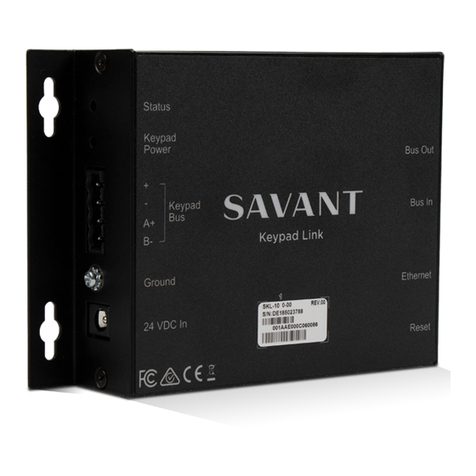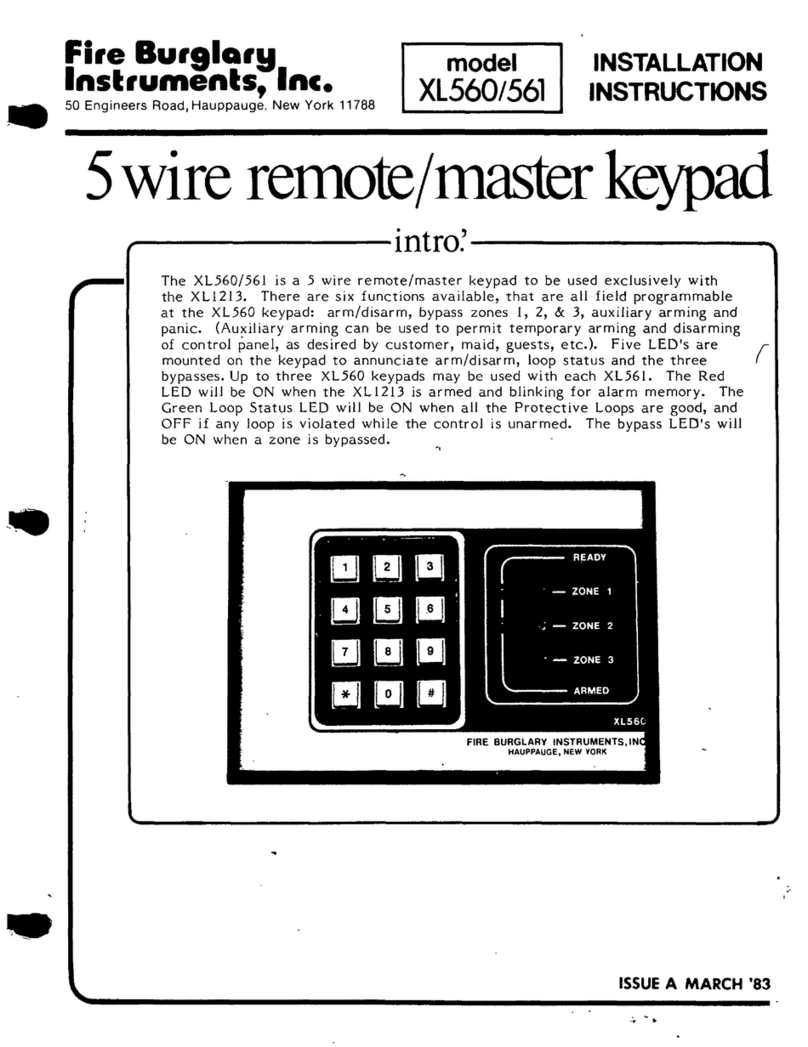B&K CK1.1 Instruction Manual

GUIDE TO INSTALLATION
B&K
CK1.1 KEYPAD
Rev A 0505

Thank you for choosing to install the B&K CK 1.1
Keypad for this system!
Please use this manual as a guide to connecting and mounting the Keypad.
The CK1.1 keypad is preprogrammed at the factory to initially operate
B&K CT products. It can be re-programmed using a Windows PC and the
accompanying CD. See the Keypad Programming Manual on the CD for
instructions on programming.
B&K Components, Ltd. sells its products through authorized dealers.
Buying from an authorized B&K Components, Ltd. dealer insures that you
have a FACTORY WARRANTY on your B&K Components, Ltd. product. A
warranty on B&K Components, Ltd. products is NOT VALID if the products
have been purchased from an unauthorized dealer or an E-tailer or if the
factory serial number has been removed, defaced or replaced in any way.
Guide to Installation of the B&K CK1.1 Keypad
© 2005 B&K Components, Ltd. All rights reserved.
B&K Components, Ltd.
2100 Old Union Road
Buffalo, New York 14227
1.800.543.5252 In NY: 716.656.0023
Fax: 716.656.1291
On the web: www.bkcomp.com

Table of Contents
Table of Contents
Features and Benefits 1
Basic Controls and Displays 2
Rear Panel Connections 3
Programming Jack - Behind the Faceplate 4
Terminate RJ-45’s One to One 4
Standard CT Receiver System 5
Connecting To A CT Receiver 6
Keypad Total Power Consumption 7
Single Gang Mounting 7
The B & K REF 5 Preamp Perfect for Adding Zones 8
Keypads with other B & K Receivers and Preamps 8
No Emitter Needed for B & K Receivers and Preamps 9
Connecting Slave Keypads 9
Controlling A Local TV or Device 10
Using IR “Eyes” with the CK1.1 11
Programming 11
White and Beige Wall Plate Included 12
CK1.1 Keypad Dimensions Front, Back, Side 12
Specifications Back

Page 1
Features and Benefits
Programming Capacity
The CK1.1 can be programmed with up to 20 IR commands or macros.
The ON and OFF buttons can additionally be programmed with a command
or macro. The soft button labels can be customized so the commands or
macros will display user friendly names that your client will find easy to use.
One Touch Automates Operation
The On, Off and all of the soft buttons can be programmed with macros of
up to 190 steps (steps can include IR commands or delays of .1 to 30 sec-
onds).
Point Any Remote Control at the Keypad!
The integrated IR pass through allows commands from infrared remotes to
pass through to the back panel and on to other sources using emitters. The
sensor can be disabled using the programming software.
Control Local TV’s and the Central System!
By connecting a flasher directly to the Keypad, you can program the IR
commands and Macros to control TV’s and other components placed in the
zone.
Two Way Communication With B&K Multi-Zone Receivers
The keypad displays the status of the zone it controls in two ways:
1. The green status LED indicates when the zone is on or off.
2. The keypad will display the current zone status when the backlight but-
ton is pressed. The zone status will scroll through the current parame-
ters such as volume, source and audio information.
Multiple Keypads within One Zone
You can daisy-chain keypads within one zone. All keypads will correctly dis-
play the zone power status.
Ultra-Fast Programming via PC Software
A vast database of more than one thousand brands instantly programs IR
Codes for most components, B&K Batch Learning does the rest in a frac-
tion of the time of any other system.
Retains Programming Through Power Failures
Your programming is safe in the event of a power failure of any length. The
Non-Volatile Flash Memory keeps the program intact.

Page 2
Basic Controls and Displays
Volume/Mute
Buttons
control the audio
level.
Power LED
Lights up
when this
Zone/Room
is ON.
LCD Buttons - Labels on the Screen change depending on what activity
has been selected.
Backlight Button
lights the keypad dis-
play & recalls status
feedback of the CT
Receiver on the bot-
tom line of the display.
Remote Control Target
conceals an IR Sensor which relays com-
mands from a hand held IR remote to
control the main system and components
connected to flashers.
Soft Buttons
Drag and drop any
command or macro
from a CK1.2 key-
pad program over to
the CK1.1.
Page Button
cycles through the 4
pages of commands
or macros.

Page 3
Rear Panel Connections
SLAVE (OUT)
Connects to the MASTER (IN) of
any other zone keypads via an RJ-
45 plug.
IR OUTPUT
The IR Output can be used to connect
an emitters directly from the keypad to
a local IR source.
MASTER (IN) Connects to the CT Receiver
via a standard 4 Pair Twisted
cable (typically referred to as
CAT 5 cable) terminated with
an RJ-45 plug.
Master Pin Out
1 - +12VDC IN
2 - KEYPAD IR DATA OUT
3 - GROUND
4 - N/C
5 - RS-232 RECEIVE INPUT
6 - GROUND
7 - +12VDC STATUS IN
8 - +12VDC IN
Slave Pin Out
1 - +12VDC IN
2 - KEYPAD IR DATA OUT
3 - GROUND
4 - N/C
5 - RS-232 OUTPUT
6 - GROUND
7 - +12VDC STATUS IN
8 - +12VDC IN

Page 4
Programming Jack - Behind the Faceplate
The face plate is removed by carefully prying up from the two screwdriver
tabs at the base of the keypad. Once removed, the Programming Jack is
revealed:
Terminate RJ-45’s One to One
Terminate the RJ-45’s using any color code, connect the cables straight
through, i.e. exactly the same color to pin on each end of the cable.
Standard pre-terminated LAN (Local Area Network) cables work fine.
For convenience, the EIA 568B color scheme is listed below. N/C = Not Connected
Programming Jack
Connect to a laptop PC via
the Serial cable included
with the CK1.1 keypad. If
your PC does not have a
serial port, utilize a USB to
serial converter.
CK1.1 MASTER[IN]
1. +12VDC IN
2. IR Data Out
3. Ground
4. N/C
5. RS-232 Receive
6. Ground
7. +12VDC STATUS IN
8. +12VDC IN
RJ-45’s Both Ends
1. White/Orange
2. Orange
3. White/Green
4. Blue
5. White/Blue
6. Green
7. White/Brown
8. Brown/White
CT-Receiver Zone Control
1. +12V (Extra)
2. IR Data In
3. Ground (Extra )
4. N/C
5. RS-232 Transmit Out
6. Ground
7. +12VDC Control Out
8. +12V
12345678
12345678
Pair 2
Orange Pair 1
Blue Pair 4
Brown
Pair 3
Green
RJ-45 Jack Pin #’sEIA-568B Pinout

Page 5
Standard CT Receiver System
Keypads connect to the Zone Control Connectors on the CT Receiver using
CAT 5 cables. CK1.1 Keypads can be coupled with CK1.2 Keypads in any
zone. CK1.1 Keypads can also operate as a stand alone zone keypad.
IR Flashers for A/V components
are connected to the IR output
corresponding to their A/V Input #.
The receiver power amplifiers connect
directly to each zones speakers.
A/V components connect using standard
audio/video cables to the numbered inputs.

Connecting To A CT Receiver
Keypads connect to the CT Receiver at the Zone Control terminals. There is
one terminal for each hardware zone labeled A-F on the CT600 and A-C on
the CT300.
You can terminate the Keypad cables to the Control terminals in one of two
ways:
1. If your cables are already terminated in RJ-45 plugs,
order the accessory “Terminal Block to RJ-45 Adapter”
(P/N 21419) separately from B&K.
Plug the RJ-45 plug into the adapter
and screw the adapter in place on the
CT Receiver. Be sure to match the
labels on the back panel to the labels under the pins
of the adapter.
AND/OR
2. You can strip the keypad cable and terminate five of the wires to the five
pin phoenix plug. If you are using CAT5 cable connected to the RJ-45 at the
Keypad, there are extra connections for Ground and 12V. These can be left
unterminated (though it does no harm to connect them). It is not important
that you use any particular color scheme, only that you connect one to one
as described here:
Page 6
RJ-45 MASTER[IN]
1. +12VDC IN
2. Data Out
3. Ground
4. N/C
5. RS-232 Receive
6. Ground
7. STATUS IN
8. +12VDC IN
CONTROL ZONE A-F
1. +12VDC IN
2. GROUND
3. RS-232 XMIT
4. DATA IN
5. CTRL OUT
CK1.1 Keypad CT Receiver

Page 7
Keypad Total Power Consumption
The CT six zone receiver 12VDC outputs can support a maximum of 20
keypads total. 10 keypads to each vertical array of three zone control con-
nections. Thus, a CT three zone receiver can support a maximum of 10
keypads. If power is being supplied to relays, screens or sensors, these
devices must be accounted for and would reduce the total number of poten-
tial keypads. Each CK1.1 keypad consumes 75mA.
Each of the zone/control cards of the CT610 are identical to the single card of the
CT310. Zone/Control cards incorporate 3 zone keypad/sensor connectors and 1
common control output. The total power consumption of all devices attac hed to one
card cannot exceed one amp.
Fam Rm KP 75 mA
Fam Rm Sensor 50 mA
Fam Rm Screen relay 200 mA
Kitchen KP 75 mA
Bedroom KP 75 mA
BedroomTV lift 200 mA
_______
Total 675 mA
Liv Rm KP 75 mA
Patio KP 75 mA
Den KP 75 mA
Den Sensor 50 mA
_______
Total 275 mA
Each of the zone/control cards of the CT Receiver are identical . The
total power consumption of all devices attached to one card cannot
exceed one amp.
Mounting
After connections are made, the CK1.1 installs into a standard single gang
J-Box or an open backed single gang trim ring with the screws provided. If
you opt to use a closed J-Box, it must be a minimum of 2 3/4” deep to
accommodate standard RJ-45 plugs in the rear. It is fastest and easiest to
mount the keypad in an open backed trim ring as shown here:
Often the best solution to mounting a B & K keypad are the
mounting plate brackets for Low Voltage Class 2 devices.
Enclosed J-Boxes can be used, they must be deep enough
to accommodate the depth of the RJ-45 connectors
plugged into the rear of the keypad (2 3/4”).
*DO NOT OVER TIGHTEN THE
KEYPAD MOUNTING SCREWS
*Intermittent backlight operation my occur.

Page 8
Keypads with other B&K Receivers and Preamps
The CK1.1 Keypad can be easily programmed with the commands for all
remote controlled B&K receivers and preamps. Because of B&K’s elegant
all discrete code-set architecture, the CK1.1 will automate and delight own-
ers of any B&K receiver or preamp. The CK1.1 integrates nicely for sec-
ond zone control of B&K theater products. The keypad(s) can be directly
connected to any B&K receiver or preamp for control of the B&K product
and/or source devices. When using the CK1.1 with B&K theater products,
zone status will display the same way when the CK1.1 is used with the CT
distributed audio/video system.
The CK1.1 Keypad can be coupled with the CK1.2 Keypad in any system or
the CK1.1 can be used as a stand alone keypad in any system. CK1.2 and
CK1.1 Keypads can be used independently in applications other than B&K
specific systems. Note: Not all features are applicable when keypad(s) are
used in systems other than B&K.
The B&K REF 5 Preamp Perfect for Adding Zones
The superb sounding B&K Reference 5 Preamp incorporates a keypad
control terminal and an IR output for flashers. A simple system would con-
nect like this:
Multiple Flashers are connected in
Series for consistent level.
+
-

Page 9
Connecting Slave Keypads
Each zone should have one CAT 5 cable home run to the CT Receiver.
When rooms interconnect and open to each other (for example: intercon-
necting family room, kitchen, dining areas are common in many homes) you
may opt to expand a zone to include several rooms. Each room can have
it’s own keypad. Many keypads can be connected in a daisy chain in any
zone. Daisy chained keypads can also operate as an independent zone
keypads if desired. Status feedback will reference the zone to which it is
connected, not the zone it is controlling.
The main system connects to the Master keypad via the MASTER [IN].
From the Master Keypad’s SLAVE[OUT] connect to the Slave keypad’s
MASTER [IN]. You can continue the daisy-chain to as many keypad’s as
you want. However, keep in mind that each keypad consumes 75mA of
power. See page 7 for more information on Total Power Consumption.
No Emitter Needed for B&K Receivers and Preamps
With the introduction of the AVR507 Series 2 and Reference 50 Series 2
theater processors, the CK1.2 and CK1.1 Keypads can connect directly to
the main RJ-45 (RS-232) jack on the back panel. B&K theater products can
support up to two keypads directly connected to the back panel. If addition-
al keypads are required, an additional 12VDC power supply must be added.

Page 10
Controlling A Local TV or Device
Every keypad can control local IR source(s) by directly connected IR emit-
ters from the keypad to the local source. A two conductor cable should be
run from the Keypad location to the local component location. Up to four
infrared emitters can be wired to a keypad by connecting in SERIES as
shown below:
To CT Receiver
Multiple Emitters should
connect in SERIES!
When connecting emitters
directly to the keypad, mul-
tiple emitters should be
connected in series. A
maximum of 4 emitters can
be connected directly the
CK1.1 Keypad. Additional
resistance is not required
when directly connecting
emitters to the CK1.1
Keypad.
Wire requirements for emit-
ters vary. Standard 2 con-
ductor speaker wire is ideal
for long runs from the key-
pad to a Local TV or
device. Utilizing CAT 5
cable will also work well.
+
-
Emitter For TV
Series Connection

Programming
Use the included CD-Rom to install B & K’s
Keypad editor on your windows PC. The CKEditor
runs on Windows 98, ME, 2000, XP and XP Pro.
It is best to do all programming in front of the
components with a CK1.1 connected to your lap-
top’s serial port. Each keypad must have its own
program downloaded to it.
To program, simply open the program, go to
the Program Menu and work your way
through the seven programming steps.
Once the program has been created in the
CK1.2 editor, select the CK1.1 tab on the
left side of the screen. Drag and Drop com-
mands and macros on the CK1.1 image.
Any macro, IR command or learned com-
mand can be programmed onto the CK1.1.
If you have questions, go to the Help Menu
and utilize the Keypad Programming
Manual.
Page 11
Using IR “Eyes” with the CK1.1
Sometimes additional IR recievers are required in some rooms in addition to
the CK1.1 Keypad. If additional IR receivers are used in a zone, they should
be treated like a slave keypad. Run a cable from the CK1.1 to the IR
receiver in the zone. The IR receiver should be pinned from the slave out-
put of the CK1.1 Keypad according the connection figure below:
IR RECEIVER CK1.1 SLAVE OUTPUT
1. IR DATA PIN 2 - IR Data In
2. Ground PIN 3 or 6 - Ground
3. 12+VDC PIN 1 or 8 - +12 VDC

White and Beige Wall Plate Included
Once programming is complete and downloaded to each keypad, finish the
installation by installing either the white or the beige wall plate. The wall
plate simply snaps into place, first from the top, finishing with the bottom. A
grey primed paintable faceplate is also available from B&K.
CK1.1 Keypad Dimensions Front, Back, Side
Page 12
Back Panel
Front Panel
w/ Faceplate Side

B&K Components, Ltd.
2100 Old Union Road
Buffalo, New York 14227
1.800.543.5252 In NY: 716.656.0023
Fax: 716.656.1291
E-mail: [email protected]
On the web: www.bkcomp.com
CK1.1 Keypad Specifications
Compatible B&K products B&K Receivers &
Preamp Processors
Operating Voltage and Current 12VDC @ 75mA
Master Inputs 1 RJ-45
Slave Output 1 RJ-45
IR Pass-through 1
IR Output 1 Phoenix (2pin)
Local Emitter Capability Yes
Installation Requirement Standard Single Gang
Included Faceplates White & Beige
Available Faceplates Primmed - Paintable
Keypad Dimensions
Height (Faceplate)
Width (Faceplate)
Depth
4.48”
2.75”
2.27”
Other manuals for CK1.1
2
Table of contents
Other B&K Keypad manuals
Popular Keypad manuals by other brands

Honeywell
Honeywell 6150 - Ademco Fixed - Display Keypad Installation and setup guide

GE
GE AL-1103 user manual
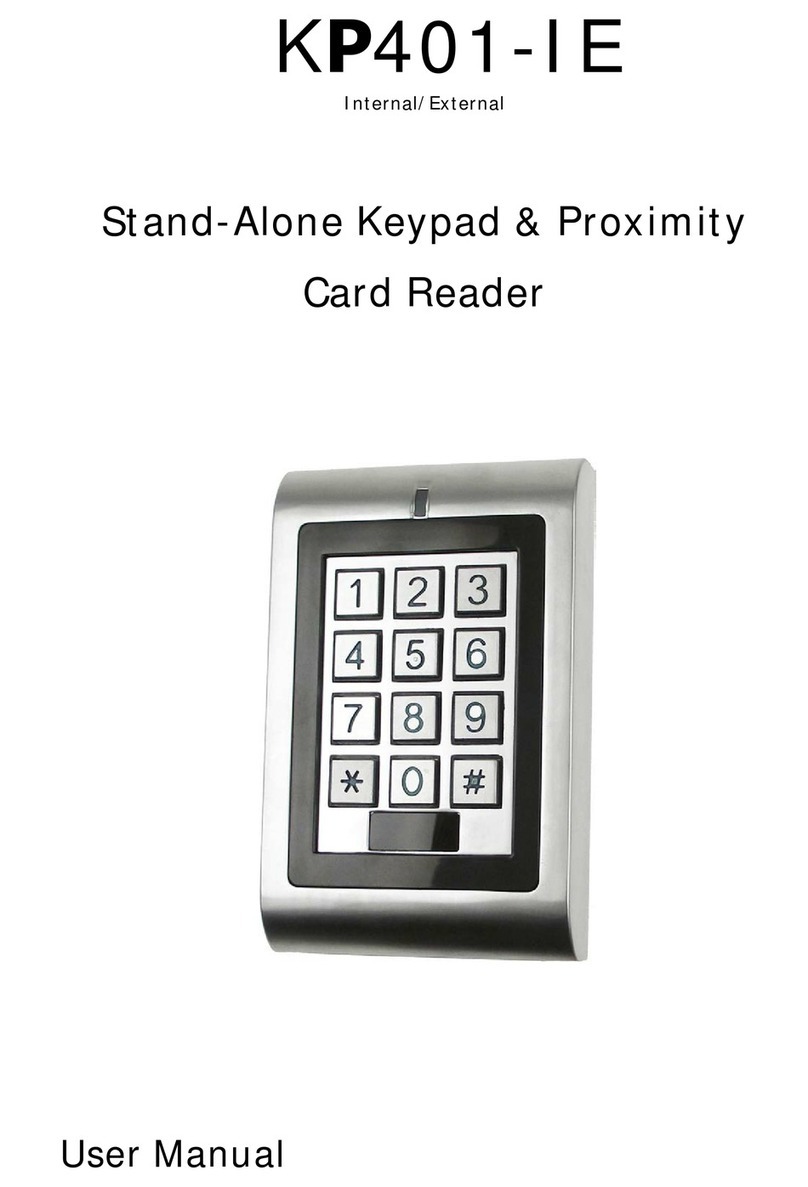
Access Security Products
Access Security Products KP401-IE user manual
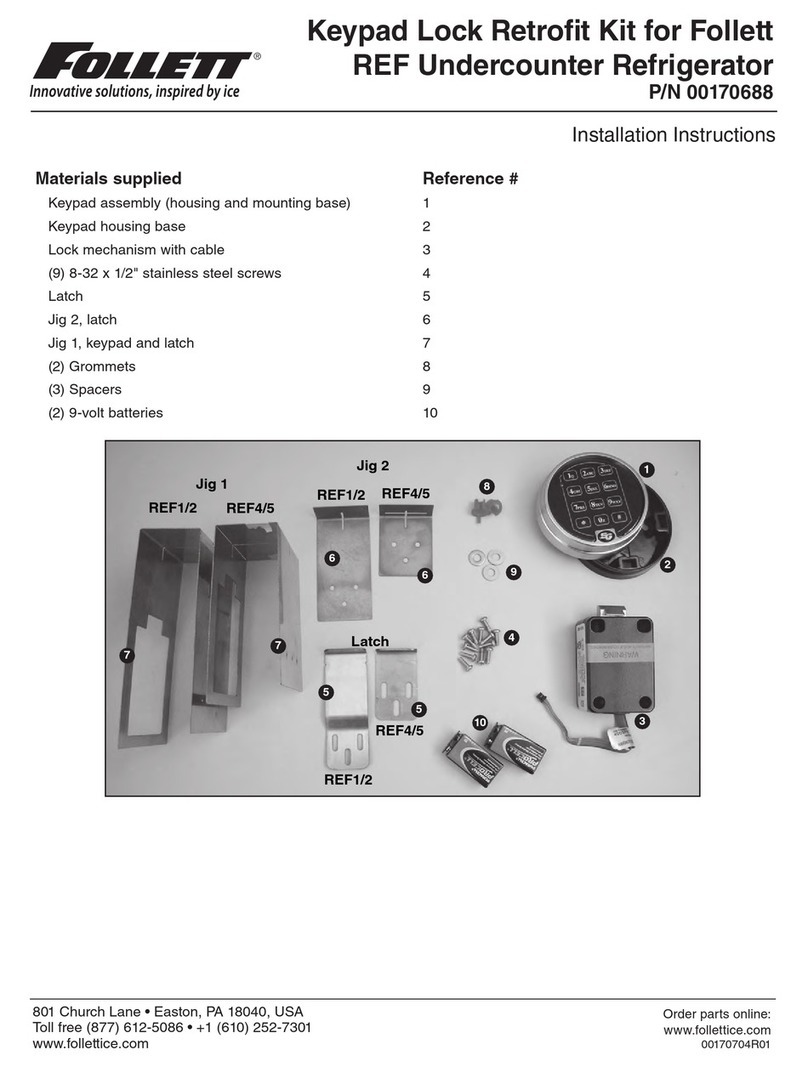
Follett
Follett 00170688 installation instructions
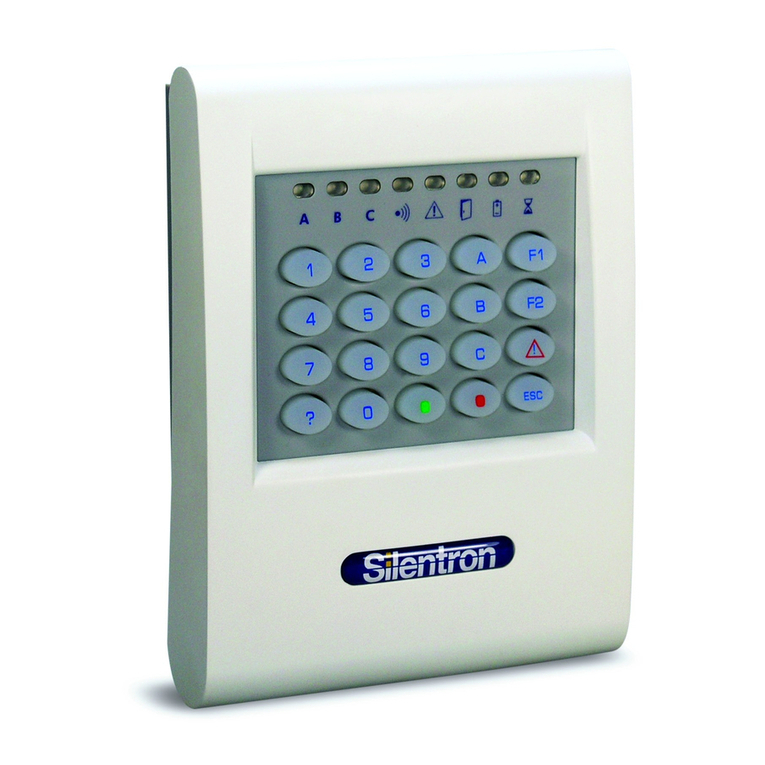
SILENTRON
SILENTRON 5528 KEYPAD HT quick start guide
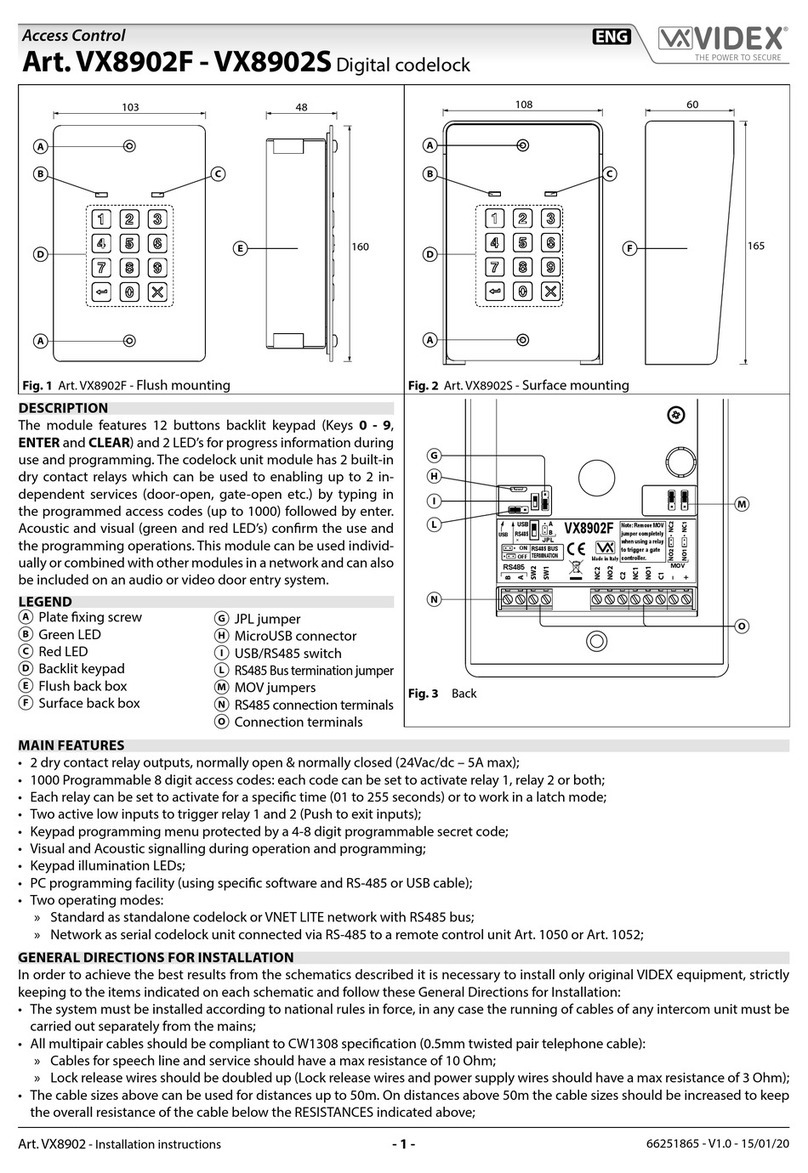
Videx
Videx VX8902F instruction manual
